The stretch of Slauson Avenue between Angeles Vista and La Brea used to be the thriving economic heart of the surrounding middle-class neighborhood. Over time, the bank, grocery store, and many other businesses dwindled, causing residents to travel over the hills to Crenshaw and other neighborhoods for many of its services. On a recent wintry Saturday, LA Commons worked with local merchants and County Supervisor Mark Ridley-Thomas to kick off a re-branding and revitalization of the former “Main Street” with a holiday block party—the Slauson Stroll.
Slauson Stroll—Looking for Main Street in South LA
Reconstitution at Crenshaw High School
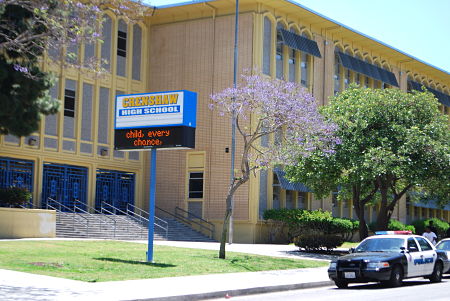 LAUSD Superintendent John Deasy’s letter, dated October 23, 2012, ordered Crenshaw Senior High School to come under the direct supervision of LAUSD’s Intensive Support and Innovation Center, “effective immediately.” Citing “four years of…less than adequate progress in….several key indicators,” Deasy informed the school that it would be divided into three magnet schools with increased AP courses and International Baccalaureate pathways. All teachers and administrative staff would have to reapply for the school’s relaunch on July 1, 2013.
LAUSD Superintendent John Deasy’s letter, dated October 23, 2012, ordered Crenshaw Senior High School to come under the direct supervision of LAUSD’s Intensive Support and Innovation Center, “effective immediately.” Citing “four years of…less than adequate progress in….several key indicators,” Deasy informed the school that it would be divided into three magnet schools with increased AP courses and International Baccalaureate pathways. All teachers and administrative staff would have to reapply for the school’s relaunch on July 1, 2013.
Sylvia Rousseau, former interim principal at Crenshaw High and now a professor in USC’s Rossier School of Education, says the Superintendent has a point. “Clearly, it has to be acknowledged that the school has not performed at the level that it needs to perform,” said Rousseau.
A program called Extended Cultural Learning was partially implemented at Crenshaw in 2011-2012, after some disappointing results on state tests in preceding years. Since implementation, proponents say the school has met or exceeded all of California’s Academic Performance Index targets for growth except one.
Based on those results, Crenshaw successfully applied for the highly competitive School Improvement Grant, or SIG, from the Federal Department of Education and administered through the State of California. Half of all SIG applications from California were rejected. Crenshaw received $6 million dollars to continue improvements at the school. That award may be in jeopardy if the school is significantly restructured.
Furthermore, says educational scholar John Rogers of UCLA, there’s just not a lot of research supporting reconstitution. “Paradoxically, despite the fact that the federal government increasingly calls for research-based reform, there really isn’t a research base for reconstitution.” said Rogers.
Why then is reconstitution becoming increasingly popular—according to one study, up to 60 percent from 10 years earlier? “I think education reform often is driven by a desire for quick & simple & often cheap answers,” said Rogers. “Lots of people are frustrated with the slow pace of reform or by schools that are not enabling young people to achieve the goals the young people have & their communities have.”
But as Rousseau underlines, a large body of data says that kids in under-performing urban schools often don’t see the relevance of education to their lives unless it has positive effects in the surrounding community. “So the students saw the relevance and the importance between education and their own capacity to make change in their community,” she said.
And Crenshaw did this through Extended Cultural Learning. That will be replaced by three magnet schools under Deasy’s proposed revamp. Rousseau says if funding isn’t stabilized, if personnel aren’t stabilized, progress will be hard to hold on to. “Unless the district takes a comprehensive view of the needs of the students, unless we take a more humanistic approach that our students aren’t widget,” she said.
Deasy and Crenshaw High faculty and staff are due to meet after the Thanksgiving holiday. It’s not clear if reconstitution is a done deal, or if there’s still room for negotiation.
New Elementary School Celebrates Opening in South LA
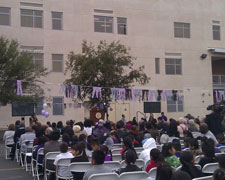
Listen to the audio story from Annenberg Radio News:
The skies were overcast, but the mood was sunny. After two years of planning and construction, the Dr. Lawrence H. Moore Math/Science/Technology Academy opened in August.
The clean-lined modernist buildings at 61st and Hooper serve 754 students, ages six-eleven. The new school helps keep classroom sizes down across the neighborhood, a fact not lost on student body president Freddy Herrera: “It is awesome that we have a new school in our area, because at the other elementary schools, it was overcrowded. Here, we don’t have that problem.”
The new academy focuses on what are known as STEM skills—science, technology, engineering, and mathematics. California Congresswoman Louise Roybal-Allard, said these skills are more critical than ever before, because “it is important to the future success of our country and our competitiveness in the world marketplace.”
A June study by Change the Equation, an organization which works to promote STEM education, said there are two jobs open for every one worker employed in science- and technology-related jobs. And those jobs are often well-compensated. Stem workers with only bachelors’ degrees often make as much as workers in other fields with advanced degrees.
A group of sixth-graders were on hand to help with the ceremonies. They were pretty happy about their new school. Jasmine Perez, 11, said it was a friendlier school than the one she’d been at before.
“In my other school, it doesn’t compare to this at all. There’s, like, many, many kids who are mean and disrespectful, and when I first came to this school, I thought, ‘I will have a happy year here.”
Sergio Castro was very clear about the pluses of the Moore Academy, saying, ”It’s easier to learn stuff here, because in the old school, I was always struggling. But here it’s way easier, you know? ‘Cause it’s quiet, and the teachers—they focus, like, they focus on the lessons a lot. In the other school, it was kind of the same, but they seem more professional [here] than the others, you know?”
And, as Jasmine pointed out, that means the kids get more attention from their teachers.
“I like this school because I have a great teacher. She’s a really rare teacher to me, because I don’t usually have a teacher who supports me and, like, pushes me, and tells me, ‘You can do this, come on! Shout-out to Ms. Grande!”
And when the kids are willing to say they actually like their school, that’s a big shout-out to the school, too.
Endeavour inspires future scientists in its new home
*Emmanuel Martinez contributed to this report.
Endeavour launched its final mission today at the California Science Center—an exhibit featuring the shuttle itself, its main engine, and the tires from its last space mission.
 Photo courtesy of Justin Higuchi (jus10h) at Flickr. Photo courtesy of Justin Higuchi (jus10h) at Flickr. |
But the exhibit will do more than show off the shuttle’s design. Jeffrey Rudolph, President and CEO of the Science Center, said, “It really is a significant moment in our efforts to inspire young people, and people of all ages, to want to learn more about science and technology and engineering, and to become our future explorers.”
The inspiration is already taking root. Students from the Alexander Science Center School were already imagining what a trip into space would be like. Amarion Arias, one of the school-children in attendance, said he wanted to be an astronaut because he would be able “to see everything that’s in the space shuttle.” Moses Ross firmly announced his intention to fly in space. “So when I grow older, I’m going to be in the space shuttle and fly in space, and I can—like gravity—I can fly on the moon.”
Former astronaut Leland Melvin flew on the shuttle Atlantis in 2008 and 2009. He says the Endeavour may launch a whole new generation of budding scientists and inventors, “a new era in discovery and imagination for every child that sees it to think about themselves building the next vehicle that’s going to take us to Mars, or being the astronaut who steps onto the Martian surface, or being a doctor that’s going to save someone’s life with stem technology.”
Even grounded, the Endeavour still remains a potent symbol of possibility.
South LA small businesses looking for missing details in USC expansion plan
With a final vote postponed until late November, The University of Southern California has a few more months to provide more details in its quest to get City approval for extensive development and renovations both on campus and on properties nearby.
Community interest has been intensely focused on University Village, a shopping development just across Jefferson Boulevard from the main campus. Opposition to the development has mostly centered on concerns about student housing to be built there. But small businesses in the area are worried about their place in the new development.
Local small businesses wonder if and how they’ll be included
The need for improvement to University Village (UV) is not in dispute. The current buildings are tatty-looking and in need of modernization and upgrades. The proposed new development will contain retail space, including a full-service grocery store, academic and administrative space, convention space, and more student housing.
Most of the businesses currently operating in UV are small, locally-owned and -operated shops, including a bicycle shop, a shoe-repair shop, an optometrist, a cigar shop, nail salons, a hair salon, and a food court populated with miniature mom-&-pop restaurants. There is also a small multi-screen discount movie theater, a discount grocery, a 99-cent store, and the lone big-box retailer, Starbucks.
The merchants running the local shops have been asking, during the mutli-year process of developing the plan, for more details on a range of issues: when they are expected to move out, what kind of help they will receive for relocation during the projected two-year demolition and construction process, and if and how they will be allowed back in. They have been given a move-out target of August 2013, but that’s the most detail they say they have received.
USC has promised relocation help, but no details have been provided in the Development Agreement so far. Nor have the merchants been told what criteria will be used to decide who will be allowed back in after construction.
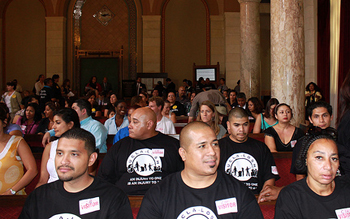 Packed aisles at Los Angeles City PLUM Meeting August 21. A vote approving or denying USC’s Specific Plan for University Village was postponed to November. Packed aisles at Los Angeles City PLUM Meeting August 21. A vote approving or denying USC’s Specific Plan for University Village was postponed to November. |
Addressing Los Angeles City Council’s PLUM (Planning and Land Use Management) commissioners at a packed August hearing, local businessman Jorge Nuno stated during public comments that the community benefit package, which will be part of the Development Agreement, doesn’t put enough emphasis on resources to help small businesses.
Nuno, who owns The NTS Group, a small advertising and marketing firm located on East 35th Street, has been studying the issue over the last couple of years. In a follow-up interview, he said he “sees a lot of challenges in the area: small businesses need to have access to the development. They need educational resources for business plans.”
USC offers free basic legal help to local small businesses
In official documents and public statements, USC points to two clinics specifically aimed at helping local small businesses. One, the Small Business Clinic, administered through the Gould School of Law, provides help with basic start-up legal paperwork to local small businesses. The Business Clinic’s services, free except for filing costs, include structuring businesses -– as corporations, limited liability partnerships, or sole proprietorships and the like. The clinic also helps draft basic contracts with vendors and clients of the participating business.
Faculty advisor Michael Chasalow said the clinic keeps the paperwork as simple as possible. “Our demographic is not fancy folk. It’s primarily salt-of-the-earth,” mom-and-pop businesses that provide services to the community. “They don’t want or need something complicated,” said Chasalow.
The purpose of the student-staffed clinic is educational -– to teach students how to craft the best service for customers, but “the benefits go to the community,” said Chasalow. In the five years the clinic has been open, it’s served almost 300 clients and currently has a waiting list. When clients need more than the SBC offers, they are referred to area non-profits like SCORE, Public Counsel, and the Pacific Asian Consortium in Employment (PACE), or the local Chamber of Commerce.
“What we offer,” said Chasalow, “is very different than the kind of advice you’d get if you went to a firm,” which would charge high fees. “If you’re trying to start a business on five-thousand dollars, an eight- hundred dollar fee is a lot.”
USC’s free business consulting clinic
USC also offers a free business consulting clinic, Los Angeles Community Impact (LACI), through the Marshall School of Business. Also student-run, LACI helps local entrepreneurs create business and marketing plans that will help them sustain and grow their businesses.
According to Neil Garvey, a junior and LACI’s vice-president for external affairs, most of the clinic’s clients need help focusing their goals. “You don’t have time to think about where your business is going if you’re just busy running the business,” but he said, “a business plan isn’t as complicated as people expect it to be.”
LACI president Jeremy Gross, also a junior, concurred, saying, “Many are spread too thin. They say yes to all their clients’ requests,” but with doing “payroll, managing staff and clients, paying the bills,” it’s aquestion of limited time and resources. “Many clients just have too many ideas. We help them winnow that.”
LACI assigns clients a team of four to five students. Over the course of a process that can stretch to up to twelve weeks, team members help clients refine their goals. The team carries out studies and surveys assessing local awareness of and interest in the client’s services, identifies possible competition, and then delivers a set of succinct recommendations and “next-steps” that clients can carry out on their own. The team then conducts a follow-up a month or so later to see how things are working out.
Is the community aware of these services?
Nuno said some small business owners he talked to confirmed USC has reached out to make them aware of these programs. But, he said, “many say they feel intimidated, because USC is talking big numbers, but they’re small businesses.”
That statement may seem a bit odd, given the fact that both clinics tailor their free services for mom-and-pops, but, said Chasalow, “with law in particular, you see people who feel they lack sophistication and may be intimidated from the get-go.”
Garvey and Gross, of LACI, feel that the sheer size of USC might lead to a perception that its programs are too hard to access. For instance, said Garvey, if you’re trying to become a vendor to the University, “the bureaucracy and red tape” of dealing with the university “is very frustrating,” even though USC has a local vendor initiative.
Gross added, “A lot of the businesses around USC don’t have a deep relationship with USC, but often want one. It’s almost like a lone market within a larger market. it’s very difficult for a mom-and-pop to get through the red tape. How do you even find out who to call?”
Said Garvey, “I think that speaks to the larger issue that USC students are a completely different market than the surrounding area. And businesses serve either one or the other, but usually not both.” That town-and-gown division might contribute to the idea that even services aimed at local small business, like the clinics, are intimidatingly inaccessible.
Loans to help local business
Some of what Nuno says is missing from USC’s current draft Development Agreement does involve larger numbers. He’d like to see “a revolving loan fund to help with relocation and business expansion…. USC could really do something big with a small amount of money,” says Nuno.
He says one to two million dollars would be ample to provide revolving loans to up to forty small local businesses.
Final city vote postponed until late November
It would be erroneous to say that the community is universally against the development. There is significant community support for the proposed improvements to shopping choices, aesthetics, and even the increased public safety that is expected as a result of the rebuilding.
But small businesses are hoping missing details will be provided in time. The current draft Development Agreement does not as yet provide them. And that’s important, because the Final Development Agreement with the City will be a legally binding document. With the final vote postponed until late November, there is still time for those details to be fleshed out. But not much time.
The lowdown on shopping carts and strollers on Metro buses
It’s not often enforced, and most riders probably don’t know about it, but it’s a Metro rule to fold up your carts and strollers on buses, trains, and subways when they’re crowded.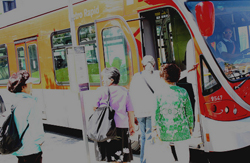
The Los Angeles County Metropolitan Transit Authority, which operates buses, subways, and light-rail trains maintains a customer code of conduct governing customer safety on its vehicles. Its most recent update, from June 2011 (http://www.metro.net/about_us/ethics/images/Customer-Code-of-Conduct-rev.pdf) states, “During crowded conditions or peak hours, remove children from strollers and materials from carts, and collapse, or wait for the next Metro vehicle that has room for the cart or stroller. This provision does not apply to wheelchairs or other mobility devices for persons with disabilities.”
The rule is enforced by drivers, conductors, or any other authorized Metro representative, at their discretion.
Mark Littman, Metro Deputy Executive Officer for Public Relations, said that bus drivers could call in Metro Transit Police should a patron refuse to comply with an order to empty and fold a cart or stroller. Littman also said that sheriff’s deputies at rail stations do actively monitor folding carts during peak hours. He emphasized that there is no outright ban on carts or strollers. Patrons can also wait for the a less-crowded bus if they don’t want to empty their carriers, he said.
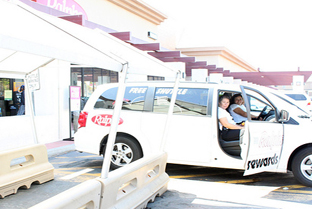 For those living in South LA and wondering how to get their groceries home without violating the rule, one grocery store in the area offers a shuttle for shoppers: The Ralph’s at Vermont and Adams has shuttle-vans that will take customers home within a five-mile radius of the store if they have purchased at least $25 worth of groceries. Customers can sit under a canopy while waiting for a van. The store operates the service from 9:30 a.m. – 10 p.m. daily and is the only Ralph’s in the area to offer shuttle service.
For those living in South LA and wondering how to get their groceries home without violating the rule, one grocery store in the area offers a shuttle for shoppers: The Ralph’s at Vermont and Adams has shuttle-vans that will take customers home within a five-mile radius of the store if they have purchased at least $25 worth of groceries. Customers can sit under a canopy while waiting for a van. The store operates the service from 9:30 a.m. – 10 p.m. daily and is the only Ralph’s in the area to offer shuttle service.
USC Representative responds to South LA housing alliance proposals for 20-year Master Plan
South LA’s affordable housing alliance UNIDAD (United Neighbors in Defense against Displacement) has been lobbying for more specifics in USC’s Specific Plan and Development Agreement, particularly about community benefits. The Plan is the agreement between the City of Los Angeles and the University which spells out how USC’s Master Plan will be implemented. The terms of the Plan will stay in force until 2030, and thus the details are of intense interest to the University and its surrounding community.
UNIDAD has five main issues: provide enough housing for students at reasonable prices; provide significant money to support affordable housing for non-students; ensure that the construction and businesses that come into the development hire a good proportion of locals; ensure that a good proportion of those jobs are permanent and above minimum-wage; provide training for those jobs; and support and enhance local businesses, rather than relying primarily on national chains.
David Galaviz, Executive Director of Local Government Relations for USC, said the university is diligently addressing these issues. The university had met with UNIDAD early in the planning process, he said, citing ten meetings altogether, but a mutually acceptable agreement could not be reached at the time.
Student Housing
USC has proposed building 5,400 new beds as part of its redevelopment of University Village, a fairly rundown shopping area just north of campus on Jefferson Boulevard. There are already approximately 7,000 university-owned beds in various locations on campus and off. About 1,000 of those will be lost in the redevelopment, leaving 4,400 actual additional beds. The Recommendation Report released by the City’s Planning Commission says that this will free up 900 housing units in the community. UNIDAD is concerned that’s not going to be enough to significantly reduce the housing pressures in the community, especially because students are often willing to pay higher rents than many in the community can afford.
Galaviz confirmed that number is not enough to house every student who needs it. But, he said, “there’s going to be two million square feet added for housing alone. That’s a lot. It may not seem like a lot, but it’s a lot. And that’s going to be five to six stories of housing…So it’s not enough housing. But do we go sixteen or seventeen stories high? We’ve heard from the community that they don’t want that.”
Galaviz pointed out that the University doesn’t have many options as to where it can build housing. It can’t go west of Vermont Avenue, an area which already has seen a high proportion of family housing convert to student housing. It can’t build to the south, because that’s Exposition Park, which is filled with museums and the Coliseum. It can’t do much to the east, because the City has a lot of industrial space there, although the university does own some land in the area.
Affordable housing
USC originally proposed setting aside two million dollars for affordable housing in the area, particularly in University Park on the campus’s north side. The City Planning Commission required USC to increase that to eight million before the Plan could be approved. That’s not as much as UNIDAD would like, but it’s a welcome improvement, said David Robinson, Political Director for Strategic Actions for a Just Economy (SAJE), a key organizer of UNIDAD.
Galaviz defended the amount, saying it would be used for many necessary community benefits, including a revolving loan fund for rehabilitation and conversion of existing privately-owned student housing back to family homes. SAJE’s Robinson counters that the amounts discussed so far would only help a relative handful of homeowners. Other possible housing mitigation could include purchasing homes, creating privately-held low-income housing projects, and creating grants for low-income housing. But these details are still to be worked out, according to Galaviz.
Jobs and training for locals
“One of the things we’re most proud of,” said Galaviz, “is that this is the largest development project in the history of South LA. We’re not using public dollars – this is financed completely by the University.” The project will include approximately 12,000 jobs, including “8,000 full-time equivalent construction jobs and 4,000 permanent jobs,” according to the Planning Commission’s Recommendation Report. Galaviz said the construction contractors will conduct outreach for local hiring and also provide training through trade apprenticeship programs. Additionally, the development will also use the city’s First Source hiring program, which requires contractors to train and hire the traditionally unemployed or under-employed for living-wage jobs. But these details are also still to be worked out.
Local small business report
The businesses to be brought in include a 25,000 square-foot grocery store. There will be an additional 325,000 square feet of commercial space for retail/shopping, restaurants, and a movie-theater complex. UNIDAD wants the largest proportion of business space to go to local businesses that will be affordable for the neighborhood. Said Galaviz, “The key price point has to meet the needs of students, faculty, and staff, and community members. We need the community to shop here to make this successful. So we have to meet their price points.”
He pointed out that the university already has multiple programs to assist neighborhood businesses, including its Supplier Diversity Services’ Local Vendor Program, the Gould School of Law’s Small Business Clinic, the Marshall School of Business’s Marshall Consulting Program, the Los Angeles Metropolitan Minority Business Enterprise Center, and the School of Policy, Planning, and Development’s Community Development and Design Forum.
Galaviz emphasized that the University still has many “regulatory hoops to jump through” before the Plan is finalized. USC wants to begin teardown of the current University Village in the early summer of next year, so those hoops have to be jumped through before then.
Community groups say USC’s Master Plan lacks guarantees for the neighborhood
Please make sure to read USC’s response to the issues raised by UNIDAD by clicking here.
Standing in the shade of a small pocket park sandwiched between modest apartments and the 110 Freeway,
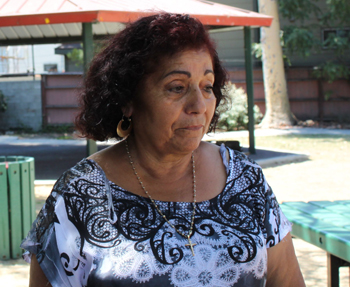 Juana Osorio is worried about getting pushed out of the neighborhood by the USC Master Plan. Juana Osorio is worried about getting pushed out of the neighborhood by the USC Master Plan. |
Juana Osorio spoke emphatically through an interpreter: “Me and my husband are on a very fixed income – we’re both already retired, so we depend on the support that my daughter and her husband living with us give us to share the rent.” Osorio is paying $1500 a month for a small house in the Estrella section of University Park, just north of USC.
The Osorios have lived in the neighborhood for almost forty years. They moved here after their previous, cheaper rental house a few streets over was sold. The new owners raised rents and the Osorios had to move.
Juana Osorio was one of the speakers on a recent journalists’ tour sponsored by United Neighbors in Defense Against Displacement (UNIDAD), a campaign launched by the Figueroa Corridor Coalition for Economic Justice, an alliance between affordable housing and activist groups. The alliance hopes to focus public attention on USC’s Master Expansion Plan, a 20-year agreement between USC and the City of Los Angeles, and its effects on the surrounding neighborhoods.
Many students, not enough housing
USC, which bills itself as the largest private employer in Los Angeles, has a total enrollment of 38,010 students. According to a 2012 study commissioned by Strategic Action for a Just Economy (SAJE) – a key member of UNIDAD – and authored by a Master’s degree candidate in USC’s School of Urban Planning, fully 71 percent of those students will not live in university-owned housing, even with additional units being built under the Master Plan.
USC currently offers 7,198 units of on-campus housing. The Master Plan, available online, says it will provide 7,600 new beds. However, the Environmental Impact Report (EIR) required by the city says that 5,200 beds will be built, but 1,200 existing beds will be lost.
The remaining students will have to live somewhere and many will fan out into the surrounding neighborhoods. These neighborhoods, which were fancy suburbs for early-20th century Angelenos, are now home to primarily low-income, working class Latinos and African Americans. The median income for the area is $18,533, making it one of the lowest-income areas in both the City and the County of Los Angeles, according to the L.A. Times’ “Mapping L.A.” project.
Beth Rodin, Director of Economic Development for Esperanza Community Housing Corporation, a UNIDAD member, said a majority of these residents pay one-third to one-half or more of their income on housing each month. And most of them live in rental housing.
Students and community compete for rentals
But with students looking to find rentals near campus, residents are often in direct competition for available housing. Scott Estevez, another speaker on the tour, is a 22-year-old whose family has lived in Esperanza affordable housing for almost eight years. He said that a friend of his father who owns rental housing in the neighborhood was told by a city housing inspector not to rent to Latinos, because they would ask for cheap rent and tear up the building, whereas students wouldn’t make a mess and would pay higher rents.
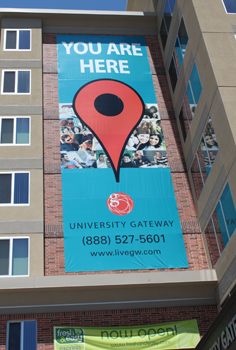 And they often do pay higher rent. Privately-owned student housing can soar to $4,000/month, which is the case at the Gateway Housing development, located on the corner of Jefferson and Figueroa. Rents for a 2-bedroom apartment are $999 per person if the bedrooms are shared with another occupant. If the rooms are rented privately, the monthly rent is $1,798.
And they often do pay higher rent. Privately-owned student housing can soar to $4,000/month, which is the case at the Gateway Housing development, located on the corner of Jefferson and Figueroa. Rents for a 2-bedroom apartment are $999 per person if the bedrooms are shared with another occupant. If the rooms are rented privately, the monthly rent is $1,798.
According to figures released by UNIDAD, only three-percent of the housing stock in the Estrella neighborhood was occupied by USC students before 1998. By 2008, that had skyrocketed to 32 percent. Other neighborhoods around the campus have been hit with soaring rents as well.
Neighborhood changes affect local businesses
Pastor Brian Eklund, who headed St. Mark’s Lutheran Church from 1968 through 2007, saw these changes first-hand. More and more family housing in what he called “a vibrant, alive community” was snapped up by absentee landlords and private property-management companies and marketed to students. Eklund said St. Mark’s, situated on Vermont and West 36th Place, and not included in the current Master Plan, lost “about a third of its membership” to the conversion of family rentals to student rentals and the subsequent exodus of families from the area. “That was always our cry from the 1990s onward,” said Eklund. “We’ve been crying ‘Build housing, build housing.’” The response has been ‘We don’t do housing.”
The Master Plan outlines redevelopment of six districts around the campus, including a mixed-use retail, academic, and conference development with student housing at the University Village shopping center, and limited expansion into the warehouse district on the other side of the 110 freeway to the east. Its Guiding Principles include “encourag[ing] and participat[ing] in neighborhood development, in concert with the greater community.”
 Jon Samore, co-owner of Vermont Outlet True Value, says USC needs to give the neighborhood more information about its plans. Jon Samore, co-owner of Vermont Outlet True Value, says USC needs to give the neighborhood more information about its plans. |
Jon Samore, co-owner of Vermont Outlet True Value at Vermont and 30th, said his store has a good relationship with the university. He and one of his brothers graduated from USC, as did several nieces and nephews. He is a former accountant for Arthur Andersen who also sits on the Board of Advisors for USC’s Leventhal School of Accounting.
Samore’s parents opened the shop in 1949; he and his brothers operate it now. Their customers and their employees come from the neighborhood. “We have two employees that live right around the corner…another one lives near Alvarado and 3rd St.,” said Samore. “We draw on the people in the neighborhood to work here.” But despite his positive feelings for the university, he wondered what the Plan “is going to do to the people in this neighborhood. We need more facts, we need more information.” According to Samore, Estevez, and UNIDAD, those details have been lacking. The discrepancies between the Master Plan online and the EIR do little to fill in the gaps.
UNIDAD’s wish list
UNIDAD wants the development agreement between the City and USC to address five issues: 1) provide enough housing for the students at reasonable prices; 2) provide significant money to support affordable housing for non-students; 3) ensure that the construction and businesses that come in as part of the Master Plan hire a good proportion of locals; 4) provide good permanent jobs for locals that are not minimum-wage; 5) provide training for those jobs; and support small businesses, rather than relying on national chains to fill retail spaces.
David Robinson, Political Director for SAJE, said it could be a win-win for everybody with thoughtful planning. “We’re not saying that USC has to sacrifice its growth and development. We are not saying that USC can actually solve all of the problems of the neighborhood – nothing like that. We’re saying we have very rational suggestions for how they can help families continue to live here, continue to work here, so that local community members and USC can prosper together.”
Dave Galaviz, Executive Director of Local Government Relations for USC, responds: “USC feels very ingrained into the social fabric of this community.” He cited multiple public meetings that were attended by hundreds of residents, many of whom expressed support for the project. (See Galaviz’ response by clicking here.)
The development agreement with Los Angeles for the Master Plan must be approved by the city’s Planning and Land Use Management (PLUM) Committee, and then approved by the full City Council. The original date for that approval was September 9, 2012, but Guadalupe Duran-Medina, Planning Deputy for PLUM’s president, City Councilman Ed Reyes, said that deadline was no longer accurate. A new deadline has not yet been decided.
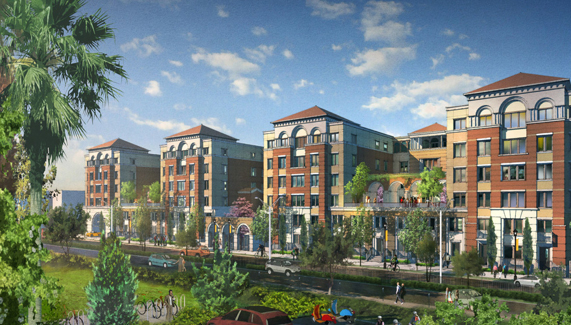
Hidden gems in South LA for homebuyers
Everyone knows that real estate is expensive in Los Angeles. And everyone knows how hard it is to get a home loan these days. So you would think that real estate agents are sitting glumly at their desks waiting for phones to ring, drumming their fingers, watching their bank accounts dwindle.
 Not in South Los Angeles, where property is selling in some areas. Leimert Park-based real estate agent Heather Presha (pronounced Pre-shay) said that homes on the market in her neighborhood and neighboring areas of Baldwin Hills/Crenshaw, View Park, Baldwin Village, Hyde Park, and Jefferson Park are getting 40 to 50 offers each. Open houses are filled to capacity with prospective buyers. “It’s so competitive now, I haven’t made an offer on a home in six months that hasn’t had multiple offers,” said Presha.
Not in South Los Angeles, where property is selling in some areas. Leimert Park-based real estate agent Heather Presha (pronounced Pre-shay) said that homes on the market in her neighborhood and neighboring areas of Baldwin Hills/Crenshaw, View Park, Baldwin Village, Hyde Park, and Jefferson Park are getting 40 to 50 offers each. Open houses are filled to capacity with prospective buyers. “It’s so competitive now, I haven’t made an offer on a home in six months that hasn’t had multiple offers,” said Presha.
Reasons to buy in South LA
Real estate agent Natalie Neith, who specializes in historic homes in South L.A., echoed Presha’s take. She said there are three main reason buyers are looking at South L.A. Firstly, these neighborhoods have preserved a lot of older architecture. Some of them need fixing up – Neith just sold an historic fixer-upper to a former writer/producer for the TV show “House” – but many are move-in-ready.
| Population by ethnicity, 2010 Census (Source: Mapping LA, LA Times | |||||||||
|---|---|---|---|---|---|---|---|---|---|
| Baldwin Hills/Crenshaw | |||||||||
| Black | 71.3% | Latino | 17.3% | Asian | 4.7% | White | 3.3% | ||
| Leimert Park | |||||||||
| Black | 46.8% | Latino | 44.9% | Asian | 2.9% | White | 2.7% | ||
| West Adams | |||||||||
| Black | 37.6% | Latino | 56.2% | Asian | 1.7% | White | 2.4% | ||
Secondly, these neighborhoods are located in the center of Los Angeles. The 110, 10, 405, and 105 freeways are roughly the eastern, northern, western, and southern boundaries, respectively, of South L.A. Almost 1 million people use just the 10 and 405 freeways daily. That central location starts to make a lot of sense if you’ve endured the clogged east-west and north-south commutes in L.A.
And finally, there is price. Buyers who are finding themselves priced out of suburban neighborhoods in the San Fernando Valley and other desirable areas of L.A. are finding they can get a lot of house for the same amount of money in parts of South L.A. Or the same house for a lot cheaper. For instance, a home that would sell in Silverlake for around $750,000 might go for $337,000 in Leimert Park, according to Presha.
Prices are beginning to inch back up after the low prices of the last several years. For example, as listed on the real-estate website Trulia, a small post-war courtyard bungalow in Village Green, an historic neighborhood in Baldwin Hills, sold for almost $400,000 at the height of the market in the late 1990s. The list-price had fallen to $185,000 in April of this year. The same bungalow sold for $195,000 this May.
Getting a loan
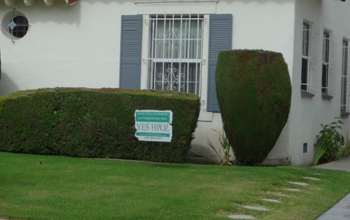 With interest rates at historically low levels of 3% or less, it’s a good time to buy if you can get a loan. Neith said if you’re buying an historic property – one that is in an Historic Preservation Overlay Zone, or HPOZ, or one that is outside an HPOZ but designated historic – then you may qualify for significant property-tax reduction under the Mills Act. The Mills Act allows tax reduction of 50 percent to 75 percent for ten years after purchase. Owners can apply for renewal after the ten-year window. However, all money saved under the act must be used for historical restoration. The West Adams area alone has at least six HPOZs.
With interest rates at historically low levels of 3% or less, it’s a good time to buy if you can get a loan. Neith said if you’re buying an historic property – one that is in an Historic Preservation Overlay Zone, or HPOZ, or one that is outside an HPOZ but designated historic – then you may qualify for significant property-tax reduction under the Mills Act. The Mills Act allows tax reduction of 50 percent to 75 percent for ten years after purchase. Owners can apply for renewal after the ten-year window. However, all money saved under the act must be used for historical restoration. The West Adams area alone has at least six HPOZs.
But even with good interest rates, Presha warned, it’s still a seller’s market. Buyers need to be prepared to provide a deposit of at least 3% of the final price, and sellers aren’t likely to cover fees or closing costs. But Presha also cautioned against being too pessimistic about one’s hopes of getting a home loan. She said prospective buyers, many of whom are single women and young professionals, who have enough money to put down for deposit often significantly underrate their chances of being approved for a loan.
Are these neighborhoods safe?
Conventional wisdom says that neighborhoods in South L.A. are unsafe. And there’s no doubt that these areas suffer their share of crime. LAPD Southwest Station Senior Lead Officer and community liaison Sunny Sasajima says it depends on how you look at the numbers. (Southwest Station patrols the neighborhoods of Adams-Normandie, Baldwin Hills, Baldwin Village, Baldwin Vista, Crenshaw, Exposition Park, Jefferson Park, Leimert Park, Union Square, University Park, Village Green, and West Adams.)
According to the L.A. Times’ “Mapping L.A.” project, over the week from July 4 – 10, 2012, Leimert Park – Officer Sasajima’s beat – saw eighteen crimes: sixteen property crimes (including burglary) and two violent crimes (robbery and aggravated assault). Leimert Park had a population of approximately 12,000 as of 2008 (the figures used by “Mapping L.A.”). According to “Mapping L.A,.” that gives a ratio of 14.6 crimes per 10,000 people. Leimert Park “averaged 3.5 violent crimes and 16.5 property crimes per week” over the last three months.
But compare that to Koreatown, an area that has a slightly safer reputation. Situated just a few miles to the northeast of Leimert Park, Koreatown is much more densely populated, with a 2008 population of approximately 100,000. During the same week, Koreatown’s crime ratio was much lower: 2.9 crimes per 10,000 people. But there were thirty-six actual crimes that week: twenty-eight property crimes and eight violent crimes (robberies, aggravated assaults, and rape). According to “Mapping L.A.,” Koreatown “averaged 10.5 violent crimes and 36.8 property crimes per week” over the last three months. Regardless of ratio to population, that’s a lot of crime in one week.
When asked about the issue of crime, Neith said, “It doesn’t make sense for me to sell unsafe neighborhoods.” Her business depends on word-of mouth referrals and repeat customers, both buyers and sellers. And that goes for Presha, too.
Both Neith and Presha stressed the importance of block-councils and neighborhood cooperation to the sense of community that prevails in West Adams and Leimert Park, their respective home neighborhoods. “[West Adams] is like a small town in a big city,” Neith said.
On the upswing
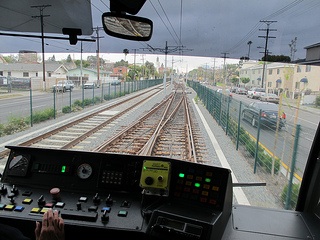 Recent improvements in South L.A. have made it a much more attractive prospect for homebuyers. The recently-contructed light rail Expo Line, which follows an old rail-line cut, is part of what Neith said is an overall feeling of good things happening in the neighborhoods along it. Even those who don’t use it think it’s “part and parcel of progressive improvement in Los Angeles.”
Recent improvements in South L.A. have made it a much more attractive prospect for homebuyers. The recently-contructed light rail Expo Line, which follows an old rail-line cut, is part of what Neith said is an overall feeling of good things happening in the neighborhoods along it. Even those who don’t use it think it’s “part and parcel of progressive improvement in Los Angeles.”
The second phase of the Expo Line will extend it out to the Veterans’ Administration Hospital on the Westside. As well, a line is planned to run north-south from Exposition and Crenshaw to the Green Line station at Aviation/LAX. The Crenshaw Line is not expected to open until late 2018, but Sasajima says he’s already hearing a lot of interest in the community about the project.
An unexpected and early side-effect is that Sasajima is losing leverage to get commercial property owners to make crime-fighting improvements to their properties, such as installing more lighting and cutting back trees. “Property owners are sitting on their hands, waiting for Metro to buy them out and begin construction,” he said.
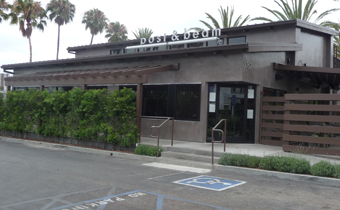 One business that thinks South L.A. is a good investment is the top-rated restaurant Post and Beam, which opened near the Baldwin Hills Crenshaw Plaza mall in 2011. With a star chef who also happens to be a local boy made good—Chef Govind Armstrong grew up in Inglewood—Post and Beam serves a locally-sourced menu driven by ingredients, many of which are raised in the restaurant’s own organic garden. It would be perfectly at home in the moneyed environs of the Westside. Yet it’s filled to capacity weekly by Baldwin Hills locals hungry for quality food and quality places nearby to spend their money in. Real estate agent Presha said, “It’s what we deserved.”
One business that thinks South L.A. is a good investment is the top-rated restaurant Post and Beam, which opened near the Baldwin Hills Crenshaw Plaza mall in 2011. With a star chef who also happens to be a local boy made good—Chef Govind Armstrong grew up in Inglewood—Post and Beam serves a locally-sourced menu driven by ingredients, many of which are raised in the restaurant’s own organic garden. It would be perfectly at home in the moneyed environs of the Westside. Yet it’s filled to capacity weekly by Baldwin Hills locals hungry for quality food and quality places nearby to spend their money in. Real estate agent Presha said, “It’s what we deserved.”
The long-awaited Marlton Square project, which has been in planning stages for almost thirty years, is also finally underway. Demolition of the ramshackle buildings which had been on the site for decades has been completed. In June, Kaiser Permanente announced that it would be the anchor tenant of the project, bringing in much-needed medical services and economic stimulus to the area. The project will also include entertainment and retail businesses.
Other improvements in the Leimert Park-Baldwin Hills/Crenshaw-West Adams areas include the arrival of grocery chain Fresh & Easy at Crenshaw and 52nd Street and major renovations at the Baldwin Hills Crenshaw Plaza shopping mall.
There’s a sense of gathering momentum in these parts of South L.A. Will they bring gentrification? Some worry about being priced out, but real estate agent Presha said, “Everybody wants the basics of a good life”— more and better shops, more accessibility, more options.
Leimert Park, West Adams, Baldwin Hills/Crenshaw. Don’t believe the negative hype. Things are happening, and these neighborhoods are ready. Home buyers are taking note.
The Expo Line: Making South LA more accessible
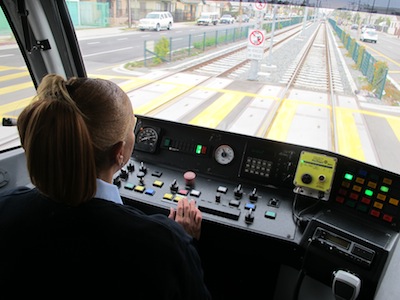 The Expo Line is Los Angeles’ newest addition to its light rail and subway system. Following an old rail line, it runs from downtown’s transit hub at 7th Street and currently ends at La Cienega and Jefferson. (The final stop of this phase of construction will be in Culver City, but that extension isn’t finished yet.)
The Expo Line is Los Angeles’ newest addition to its light rail and subway system. Following an old rail line, it runs from downtown’s transit hub at 7th Street and currently ends at La Cienega and Jefferson. (The final stop of this phase of construction will be in Culver City, but that extension isn’t finished yet.)
This route takes the rail line through some of L.A.’s most underserved and poor neighborhoods. These neighborhoods are also some of L.A.’s most diverse and densely populated.
The Expo Line increases access to and from these neighborhoods. It will bring change to them – more business coming in, easier access to jobs and services for residents. This is hopefully for the better, but change can bring unintended consequences.
To give a better sense of what the Expo line will mean to South LA communities, we’ve created a slideshow featuring the intersections at the four westernmost stops on the line currently — La Cienega/Jefferson, Expo/La Brea, Expo/Crenshaw, and Expo/Western.
The obejctive of the slideshow is to create a brief record of what these neighborhoods look like at the beginning of these changes.
[Note: Click on each box to view the slideshow. It does not play automatically; you need to keep clicking on the images to move through the slideshow.]
A stop at La Cienaga and Jefferson shows the neighborhood has a mix of residential, commercial and industrial property. Those who don’t know the area will be surprised to know that some manufacturing still exists in South LA.
You won’t find a grocery store, but when you exit the Expo/La Brea stop, you’ll find a mini-mall and a West Adams landmark: Music Man Murray’s.
The Expo/Crenshaw stop is the home of two of the area’s most recognizable landmarks: the West Angeles Cathedral and Earlez Grille. The Expo/Western stop is bustling with activity and lots of businesses highlighting the area’s population diversity, which is 56 percent Latino and 38 percent African American.














